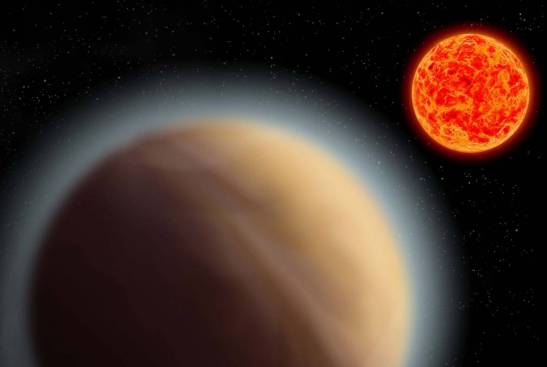Earth-sized planets, also called rocky, are composed of an iron core and a rocky mantle in a similar proportion to what we find on our planet. However, the universe never ceases to amaze, and recent discoveries are beginning to suggest that the compositional diversity of these worlds may be greater than previously thought.
Now, an international study, led by researchers at the Center for Astrobiology (CAB, CSIC-INTA) and published in the journal astronomy and astrophysics, analyzed in detail the super-Earth TOI-244 b, which orbits around a red dwarf star located 72 light-years away. The results reveal that this exoplanet may be shrouded in a thick, humid atmosphere.
The density of super-Earth TOI-244 b is almost twice as low as expected for its size and mass
The TOI-244 b signal was detected in 2018 by NASA’s TESS space mission, and the authors used its data to carry out the study, along with those collected by the ESPRESSO instrument at the Paranal Observatory, belonging to the European Southern Observatory (ESO) and located in the Atacama Desert (Chile). Thus, they were able to confirm and characterize this new exoplanet in depth.
The data show that this exoplanet is 1.5 times larger than Earth and 2.7 times more massive. These measurements correspond to a density almost twice as low as expected, placing TOI-244 b a long way from the typical characteristics of other terrains.
“It was a really surprising result and one that none of us expected before starting the research,” says Amadeo Castro-González, predoctoral researcher at CAB and lead author of the study.
Why is it so sparse?
The researchers analyzed several possibilities to explain the low density of this rocky planet. First, they considered that its core had little iron and therefore harbored an extensive layer of rock. However, they ruled out this possibility, as calculations indicated that even a planet made entirely of rock would not have a density as low as that observed in TOI-244 b.
So they thought of another alternative: that the low density of the planet was due to the existence of an extensive atmosphere. While this atmosphere may have initially been composed of light chemical elements abundant in planet-forming regions, such as hydrogen and helium, the star’s ultraviolet and X-ray radiation would have evaporated this primordial atmosphere, leaving a secondary atmosphere composed mostly of water.
Scale representation of the exoplanetary system TOI-244 (left) and the planetary structure of TOI-244 b compared to that of Earth. / J. Lillo Box & A. Castro González
Its water vapor hydrosphere can be between 400 and 600 km thick, that is, about 50 times more extensive than the Earth’s atmosphere.
Based on this possibility, the researchers carried out simulations that suggest that TOI-244 b has a solid structure similar to that of Earth that would be surrounded by a hydrosphere composed of gaseous and supercritical water with a thickness between 400 and 600 kilometers. it is about 50 times more extensive than Earth’s atmosphere.
“Given the conditions of temperature and humidity on the surface of the planet, the climate of TOI-244 b would be similar to the interior of a wet sauna of planetary dimensions which, of course, given the extremely high temperatures and pressures, would be very hostile to the planet, the most forms of life that we know,” explains Amadeo.
Population of planets with inflated atmospheres
Only a handful of planets out of more than 5,300 found to date have similar properties to TOI-244 b. Thanks to this discovery, the authors propose the existence of a possible new population of rocky planets with inflated atmospheres. These planets tend to orbit stars that are low in metal content and which also tend to receive lower stellar radiation than denser super-Earths.
New emerging population of inflated super-Earths. / A. Castro-González et al./CAB
“These trends can provide us with very valuable information about the nature of these objects, but better characterized planetary systems are still needed to confirm them with certainty. If confirmed, it would suggest that the presence of an extensive hydrosphere could not only be the most likely explanation for the structure of TOI-244 b, but also for a new emerging population of inflated super-Earths,” concludes Amadeo.
“These results deepen the need to understand planetary genetics, the formation and evolution conditions that lead us to find such a rich diversity of exoplanetary systems”, says author Jorge Lillo Box, also a CAB researcher and supervisor of Amadeo’s thesis.
“The results of this investigation result from the collaboration between several institutions at an international level and have been conducted by a researcher in the pre-doctoral phase, demonstrating the value and capacity of the new generations of scientists in our country”, concludes Lillo .
Reference:
A. Castro-González et al. “A super-Earth of unusually low density transiting the bright early-type M dwarf GJ 1018 (TOI-244)”. Astronomy and Astrophysics, 2023
